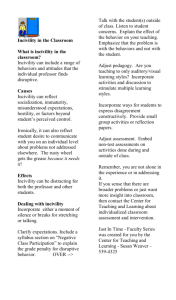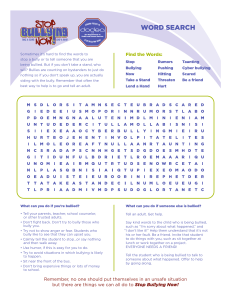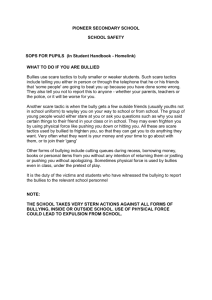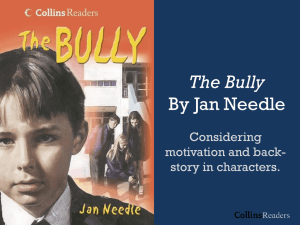PowerPoint document
advertisement
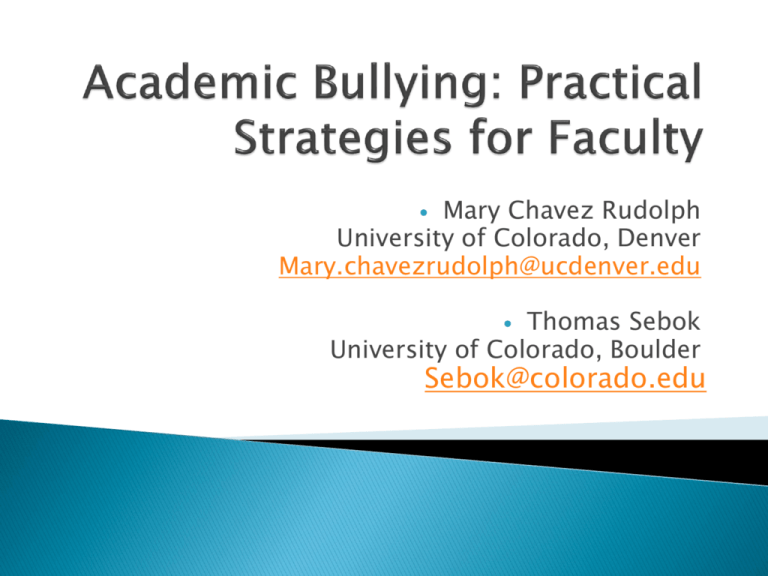
Mary Chavez Rudolph University of Colorado, Denver Mary.chavezrudolph@ucdenver.edu Thomas Sebok University of Colorado, Boulder Sebok@colorado.edu Student Incivility Factors that Affect Conflict ◦ Perceptions ◦ Emotion ◦ Communication Incivility in Academia Faculty Incivility & Bullying Interventions STUDENT INCIVILITY IN THE COLLEGE CLASSROOM FROM A FACULTY PERSPECTIVE: RACE AND GENDER DIFFERENCES IN PERCEPTION, ATTRIBUTION, EFFECT, AND RESPONSE Mary Chavez Rudolph, 2005 Doctoral Dissertation sleeping in class prolonged chattering excessive lateness poor personal hygiene overt inattentiveness eating, drinking, gum chewing, smoking carrying pagers and beepers passing notes unexcused exits from class verbal or physical threats to students or faculty disputing the instructor’s authority and expertise Incivility by one student or by many students has the potential to severely compromise the effectiveness of the classroom instruction and learning. “In related studies, where I tracked new faculty longer, these traumatic events (CI) [Classroom Incivility] and resulting impressions of undergraduates as adversaries were among the few early turning points that derailed careers.” (Boice, 1998) Nature of Students ◦ Student Mental Health ◦ Consumer Attitude ◦ Student Learning vs. Faculty Teaching Nature of Society, the Classroom, the Course ◦ Incivility in Society ◦ Informality of Organizations ◦ Large Classrooms Instructor Behaviors Increasing ethnic and gender diversity of students and instructors, and that SI and conflict is a reflection of cultural differences. What are the different perspectives of the parties in this situation? How does this affect this conflict? How is emotion affecting this conflict? How is communication affecting this conflict? Perceptions ◦ Identity, History Emotion Communication “…conflict lies not in objective reality, but in people’s heads.” Fisher and Ury, 1991 Check out Assumptions ◦ Put yourself in their shoes ◦ Ask / Discuss Perceptual Errors Emotion and (is) Motivation ◦ Both move us in some way, as implied by the common Latin root of both words (movere, to move). Brian Parkinson and Andrew M. Colman, 1995 ◦ Emotions are often precursors of motivational phenomena. Oatley, 1992 “Emotion as Insight” Managing Emotion Jones & Brinkert, 2008 Timing and Setting Active Listening Open-ended questions I language Limit-Setting Issue Consequences DEFINING “INCIVILITY” “Civility” – concern, regard, and respect “Behavior that helps to preserve the norms for mutual respect at work.” “Incivility” – rudeness, disregard, and mistreatment Andersson and Wegner (2001) Norms for the organization erode Spiraling and Cascading “Incivility goes unchecked and can escalate leading to a chain of more aggressive, coercive behaviors possibly leading to violence.” Pearson, Andersson, and Porath, 2000 Unique Factors Culture of Critique Student Development Tenure and Rewards for Faculty Department Chair (Head) Role Unique Factors Funding Free Speech/Academic Freedom Free Speech/Right of Dissent Conflict Avoidant Culture Not So Unique Factors Physical Separation External and Internal Customer Service Challenges Evaluative Relationships Peer/Colleague Relationships Susan and George Definition of Workplace Bullying: ◦ Workplace Bullying is repeated, health-harming mistreatment of one or more persons (the targets) by one or more perpetrators that takes the forms of: verbal abuse, offensive conduct/behaviors (including nonverbal) which are threatening, humiliating or intimidating, and/or work interference -- sabotage -- which prevents work from getting done. (Workplace Bullying Institute) Threat to professional status (e.g., belittling opinion, public professional humiliation, accusation regarding lack of effort); Threat to personal standing (e.g., name-calling, insults, intimidation, devaluing with reference to age); Isolation (e.g., preventing access to opportunities, physical or social isolation, withholding of information); Overwork (e.g., undue pressure, impossible deadlines, unnecessary disruptions); Destabilization (e.g., failure to give credit when due, meaningless tasks, removal of responsibility, repeated reminders of blunders, setting up to fail). (Rayner, Charlotte, 1997) Bullies 50% men / 50% women 81% of bullies are bosses 14% peers, or co-workers 5% bully a higher ranking target Targets Women are the majority of targets (3/4 of all) Men bully women in 69% of the cases / women bully women 84% of the time Rank Health Item 1 Anxiety, stress, excessive worry 2 Disrupted sleep / Exhaustion 3 Loss of Concentration 4 Feeling edgy, irritable, easily startled, on guard (paranoia) 5 Obsession over details of bully’s tactics 6 Stress Headaches 7 Racing Heart Rate 8 Diagnosed Depression 42% of the cases - perpetrator’s immediate bosses directly helped the Bully or punished the complaining Target 40% of the cases - Bullies’ managers did nothing to intervene (tacit support) 32 % of the cases - HR supported the Bully or did nothing (51% of the cases) 11% of the cases - the Target’s co-workers sided with the Bully 7% of the cases - negative sanctions against the bully (censure, transfer, or termination) United States In the U.S. the law is attentive to harassment or discrimination when it relates to sex and race (Title VII). U.S. Courts have consistently ruled that rude and even abusive behavior does not violate federal EEO laws unless it is directed at an individual (or group of individuals) because of his or her race, color, religion, sex, national origin, age or disability. The “equal opportunity harasser” defense. Awareness raising Policy or code - gives victims the confidence to seek redress and reduce the benefit/cost balance for those tempted to bully others Anger and frustration management for bullies Work w/individuals – assertiveness training, make changes in the structure (physical space, reporting, etc.), conflict management, mediation Training to encourage intervention Training to identify options for bystanders Encourage the identification and discussion of unacceptable behavior Goals and Interests Strategies Conflict Styles Communication Maslow’s Hierarchy of Needs ◦ Physiological ◦ Security ◦ Social ◦ Esteem ◦ Self-Actualization Generate Options Identify Pros and Cons Evaluate Options based on Goals & Interests Most people have one or two preferred styles of responding to conflict Thomas and Kilmann developed an instrument to help people determine their preferred style Utilization of a particular style should be situation-dependent Compete Collaborate Compromise Avoid Accommodate How to set up an environment that is respectful or turn a disrespectful environment around… What do you want? ◦ What respectful behaviors do you want to increase? 3-4 minutes brainstorms

